Purple is one of the rarest plumage colors in the bird world. But a few lucky purple beauties exist. However, only a handful of species are bright purple all over. For example, most somewhat purple birds have patches of purple or appear iridescent in the sun. Discover these 12 purple birds, including how to identify them and where they live.

1. European Starling
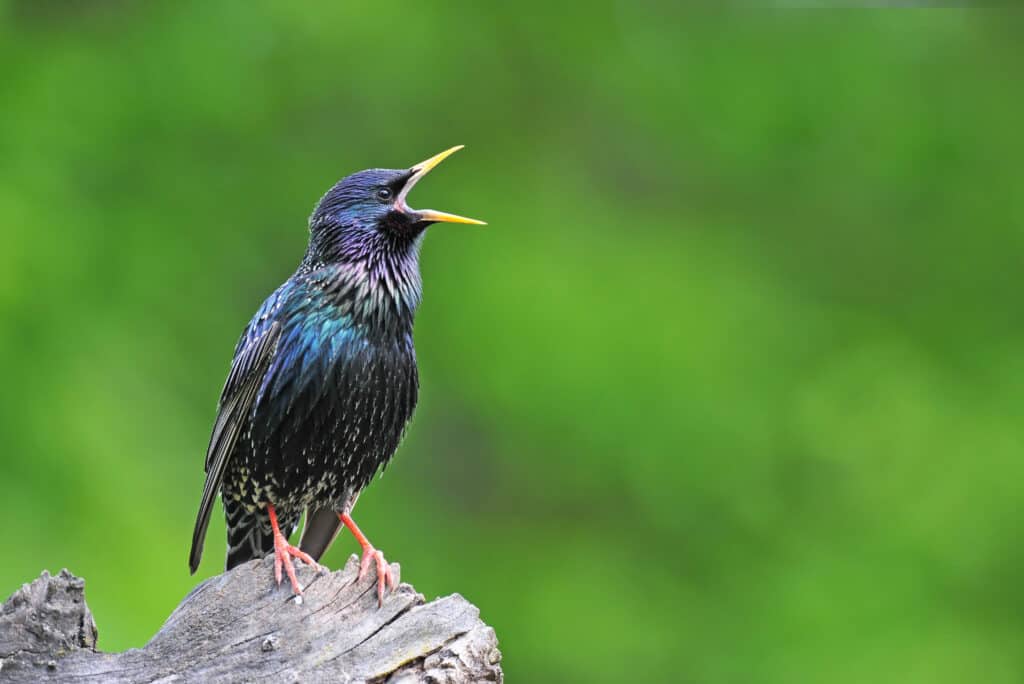
European starlings are excellent mimics and can imitate other birds, machinery, and human speech. They are native to Europe, Asia, and
Africa
.
©Soru Epotok/Shutterstock.com
Characteristics: The European starling is one of the most well-known purplish birds in the United States. Though these stocky birds with long bills and short tails appear black, they actually feature a purple, blue, and green glossy sheen. It is best seen in the summer sun.
Location/Habitat: They are native to Europe, Asia, and Africa. But they are also abundant throughout the United States and Canada as an introduced species. They are common in towns, cities, backyards, parks, and fields.
2. Purple Martin
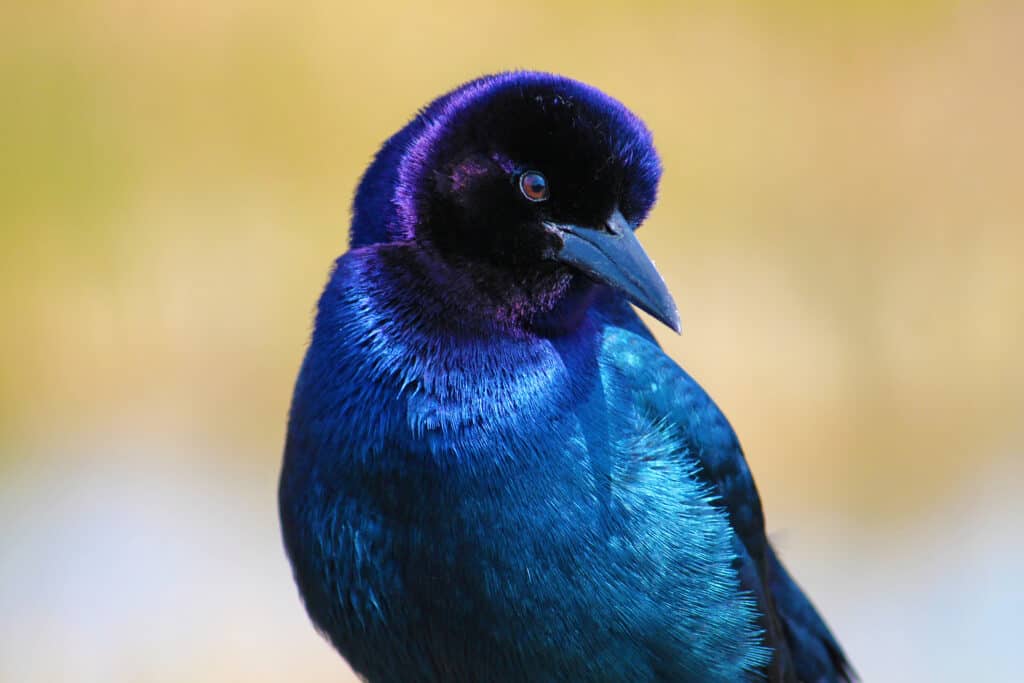
Purple martins have an average wingspan of 15 inches and a length of 7.9 inches. Up close, they are iridescent purple and blue.
©iStock.com/KennShapiro
Characteristics: These large swallows feature slightly hooked bills, broad chests, forked tails, and long wings that taper off. Adult purple martins are shiny dark bluish-purple with black wings and black tails. However, they look black from a distance.
Location/Habitat: These long-distance migrants breed in the Eastern United States and Canada before migrating to South America for the winter. You can find them in open fields, wet meadows, parks, and towns.
3. Purple-Breasted Cotinga
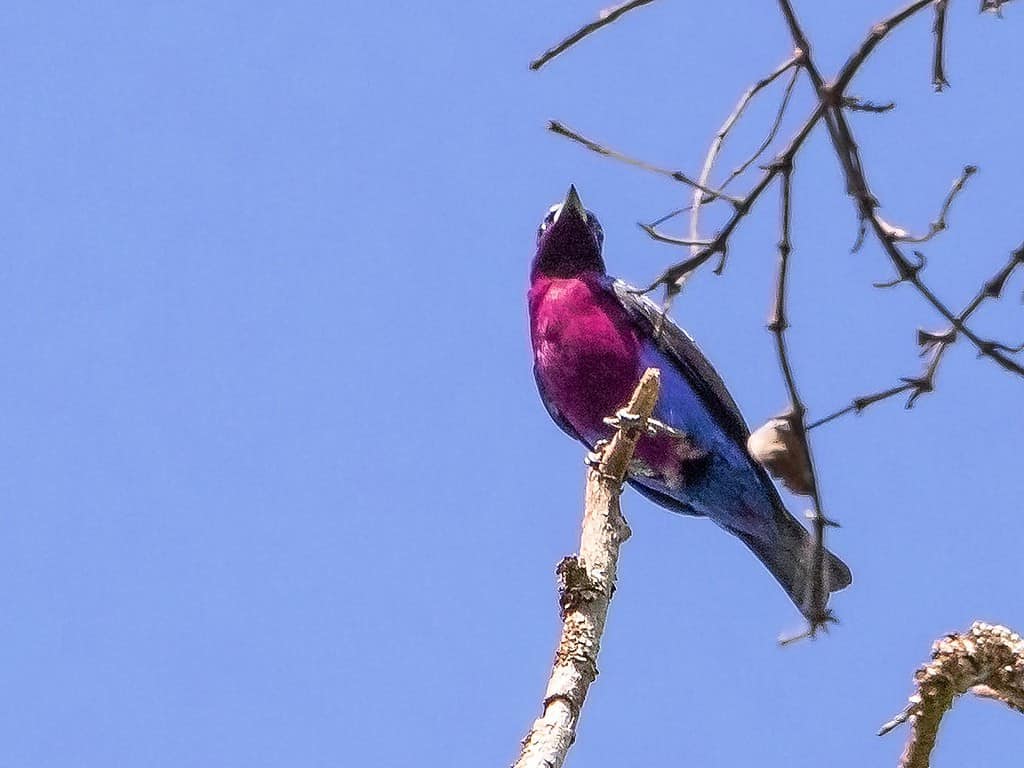
Purple-breasted cotingas live in the rainforest canopy of moist lowland forests. They are turquoise, blue, purple, and black.
©CC BY-SA 4.0 – License
Characteristics: The purple-breasted cotinga is a medium-sized tropical bird with a plump body and a small head. These brightly colored birds are striking because of their turquoise to blue, purple, and black plumage. But only the males are colorful. Females are brown with spotted breasts.
Location/Habitat: They are found in seven South American countries, including Brazil, Colombia, Venezuela, Guyana, Peru, French Guiana, and Suriname. These cotingas live in the rainforest canopy of moist lowland forests.
4. Violet-Backed Starling

The metallic purple feathers of the male violet-backed starling are used to attract a female. These birds inhabit arid open woodlands and clearings.
©iStock.com/Michael Fitzsimmons
Characteristics: The violet-backed starling is a small starling with vibrant, iridescent plumage. Males are white below and bright violet above, while females are streaky brown with no bright coloring. Additionally, they feature black bills, black legs, and yellow eyes.
Location/Habitat: They live in Sub-Saharan Africa, where it is a relatively common bird. These birds inhabit arid open woodlands, clearings, and gallery forests.
5. Purple Honeycreeper
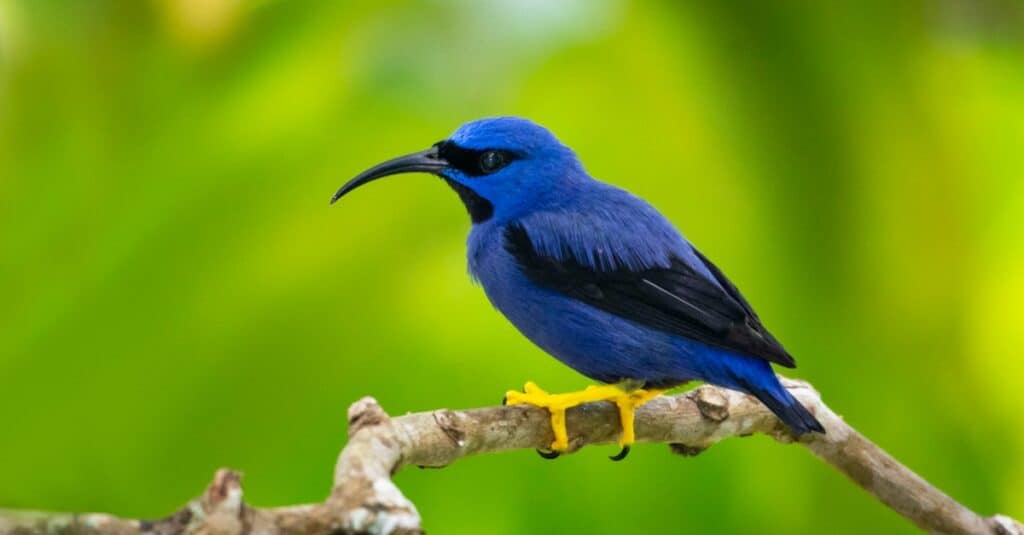
The purple honeycreeper has bright, purple feathers with black wings. Their long decurved bills and vibrant coloring are their discernable features.
©iStock.com/Chelsea Sampson
Characteristics: Purple honeycreepers belong to the tanager family. They are small colorful birds found in the Neotropics. Their long decurved bills and vibrant coloring are their most discernable features. Adult males are dark purple-blue with black wings and tails.
Location/Habitat: This species lives in the northern part of South America in lowland forest canopies. You can also spot them in citrus and cocoa plantations.
6. Purple Grenadier
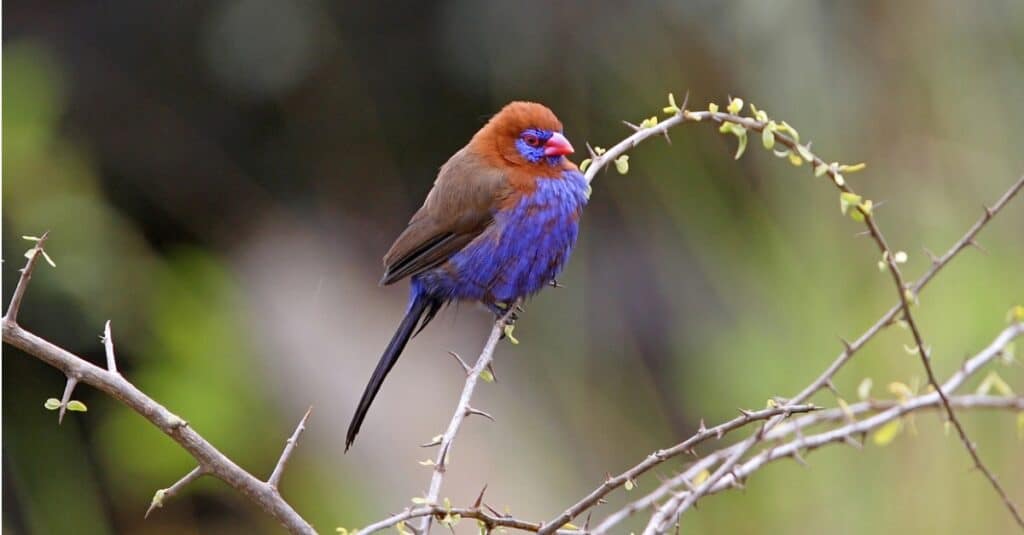
The purple grenadier has a beautiful color combination of chestnut brown and muted violet. Their tails are black, and their bills are red.
©iStock.com/neil bowman
Characteristics: The purple grenadier is a small seed-eating bird with unique coloring. Males have red heads, a blue patch around their eyes, and a purplish-blue body. Additionally, their tails are black, and their bills are red. Females feature cinnamon-brown plumage and white barring.
Location/Habitat: This species inhabits tropical shrublands in Eastern Africa, including Kenya, South Sudan, Somalia, Uganda, Ethiopia, and Tanzania.
7. Varied Bunting
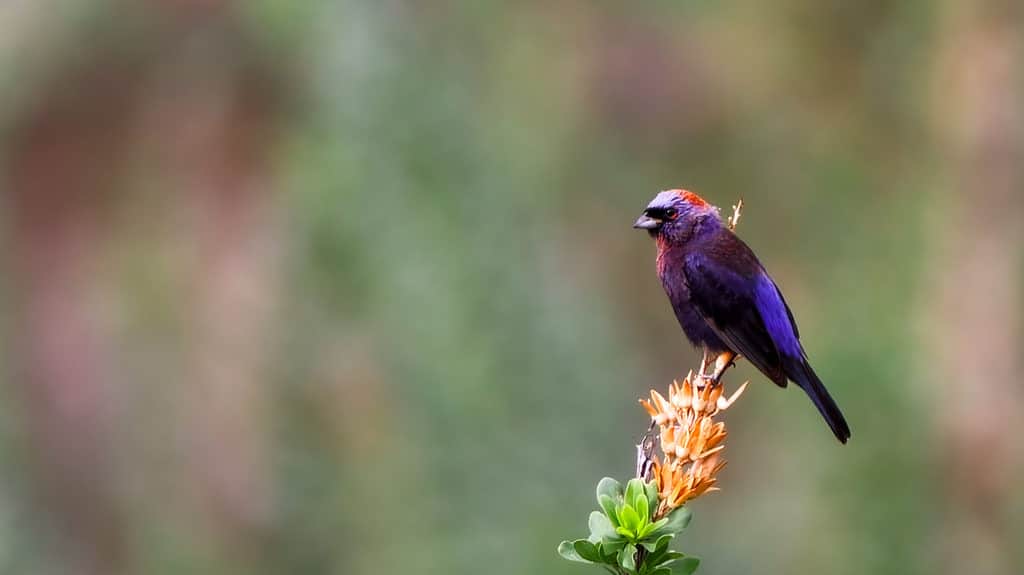
Varied buntings prefer dense cover in arid areas, like canyons or thorn forests. Males during the breeding season are deep purples and reds.
©iStock.com/Banu R
Characteristics: Varied buntings are small songbirds with long tails and thick conical bills. Adult males during the breeding season are a mix of deep purples and reds. However, outside of the breeding season, they feature dark brown plumage. Additionally, they have black on their faces and red eye rings.
Location/Habitat: These buntings live in the Southwestern United States and Mexico. They are short-distance migrants who move to Southern Mexico during winter. They prefer dense cover in arid areas, like canyons, thorn forests, and desert washes.
8. Costa’s Hummingbird
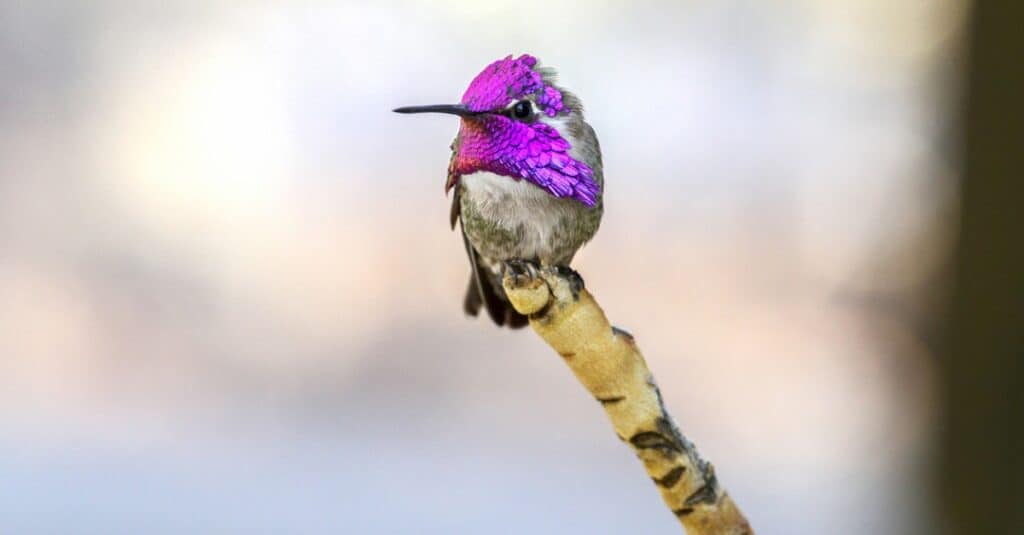
Unlike this male, the female Costa’s
hummingbird
doesn’t have purple feathers. Females have dull plumage, featuring green and white.
©iStock.com/Monica Lara
Characteristics: These small, plump hummingbirds have short tails. They are especially cute because their throat patch looks like a mustache. Adult males are olive green and gray but have purple iridescent crowns and throats. Females have more dull plumage, featuring green and white.
Location/Habitat: Costa’s hummingbird lives in the far Southwestern United States and Mexico along the coast. Examples of habitats include desert scrub, coastal scrub, and deciduous forests.
9. Purple Gallinule

The purple gallinule is royal purple and dark green. This species lives in the Southeastern United States, Mexico, and Central and South America.
©iStock.com/David McGowen
Characteristics: The purple gallinule is a medium-sized wading bird featuring characteristic long legs and toes. They also have thick, conical bills and short tails. Adults are royal purple and dark green. Additionally, they have bright yellow legs and bright red bills. For this reason, they definitely stand out amongst their environments.
Location/Habitat: This species resides throughout the Southeastern United States, Mexico, Central America, and South America. They are abundant in South America, where they live year-round. They mainly inhabit freshwater marshes, but you can also find them on lakes, ponds, reservoirs, and rice fields.
10. Violet Sabrewing
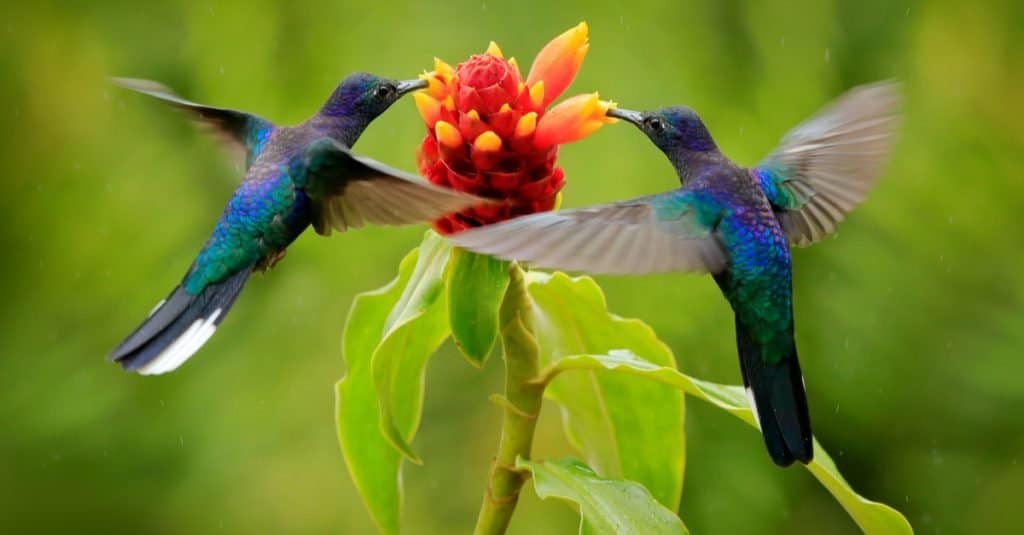
Blue hummingbird, Violet Sabrewing, flying next to a beautiful red flower, sucking nectar in a tropical forest in Costa Rica.
©Ondrej Prosicky/Shutterstock.com
Characteristics: The violet sabrewing is a large species of hummingbird featuring long tails and long, decurved bills. Males are a mixture of glossy, iridescent blue, purple, green, and black. Additionally, their napes are metallic violet. Females are bronze and metallic green.
Location/Habitat: These hummingbirds live permanently in Southern Mexico and Central America. They inhabit humid evergreen forests, banana plantations, and gardens.
11. Gray-Headed Swamphen
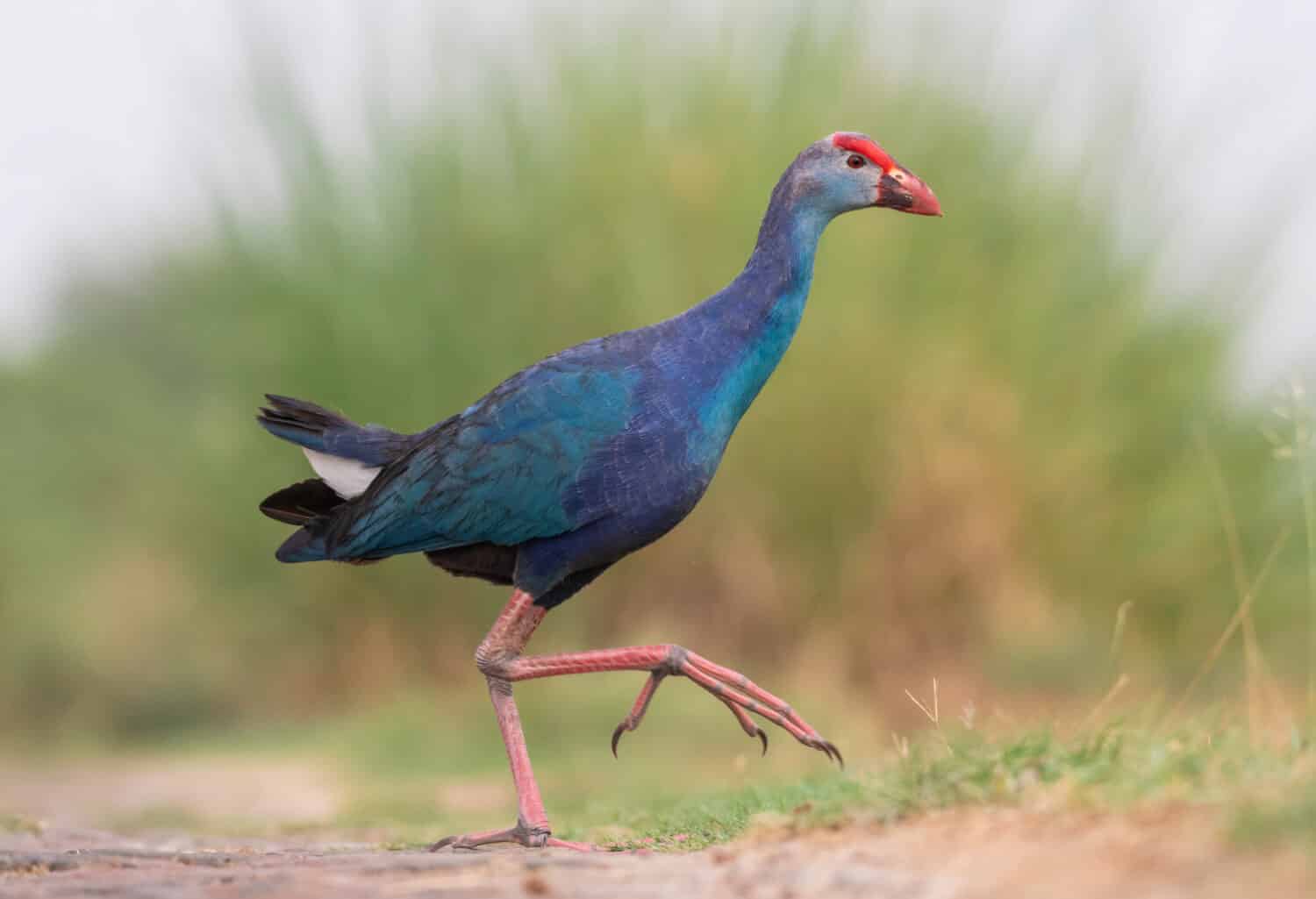
Gray-headed swamphens are waders with long legs and long toes.
©Pictures Punetha/Shutterstock.com
Characteristics: The gray-headed swamphen is a large wading bird known as a rail. They get their name from their chicken-like appearance. However, like other waders, they have long legs and toes. They also possess thick necks, heavy bills, and short tails. Their bodies are a mix of green and purple. Additionally, they feature bright red bills and frontal shields.
Location/Habitat: They have a very small range in the southern tip of Florida, where they live year-round. These rails live in many of Florida’s wetlands, including marshes, sloughs, ponds in golf courses, and artificial wetlands. However, they tend to avoid saltwater wetlands.
12. Violet-Crowned Woodnymph

The violet-crowned woodnymph male is violet while the female is green.
©iStock.com/neil bowman
Characteristics: The violet-crowned woodnymph is a long hummingbird featuring slender bodies and long bills. Males are vibrant and metallic, with violet, bronze, and green plumage. Their throats are so shiny they look like sequins. Females are gray and bluish-green and are not as iridescent.
Location/Habitat: This hummingbird is found in the northern tip of South America, from Belize to Peru. They live in the interior and edges of humid forests. But you can also find them in cacao plantations and gardens. Violet-crowned woodnymphs are considered emerald hummingbirds, and they belong to the Trochilidae family.
Summary of 12 Purple Birds
| Rank | Purple Bird | Native Location/Found in: |
|---|---|---|
| 1 | European Starling | Native to Europe, Asia, and Africa |
| 2 | Purple Martin | Eastern United States and Canada; migrate to South America for the winter |
| 3 | Purple-Breasted Cotinga | Seven South American countries |
| 4 | Violet-Backed Starling | Found in Sub-Saharan Africa |
| 5 | Purple Honeycreeper | Northern part of South America |
| 6 | Purple Grenadier | Eastern Africa |
| 7 | Varied Bunting | Southwestern United States and Mexico; migrate to Southern Mexico |
| 8 | Costa’s Hummingbird | Far Southwestern United States and Mexico |
| 9 | Purple Gallinule | Southeastern United States, Mexico, Central America, and South America |
| 10 | Violet Sabrewing | Southern Mexico and Central America |
| 11 | Gray-Headed Swamphen | Southern tip of Florida |
| 12 | Violet-Crowned Woodnymph | Northern tip of South America |
The photo featured at the top of this post is © iStock.com/Michael Fitzsimmons
Thank you for reading! Have some feedback for us? Contact the AZ Animals editorial team.






